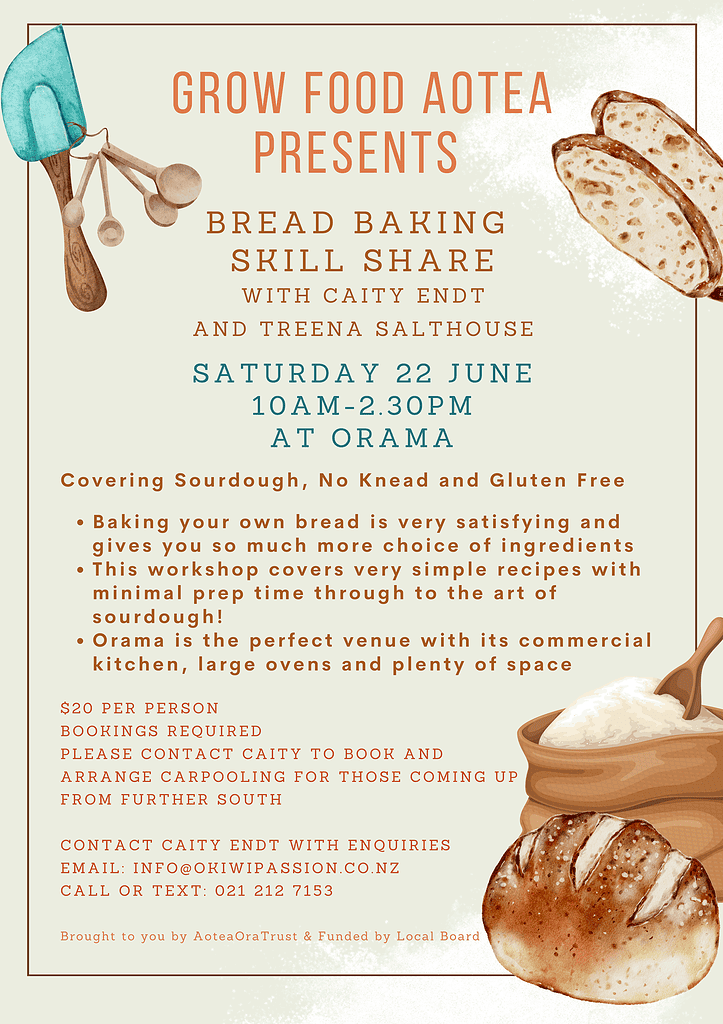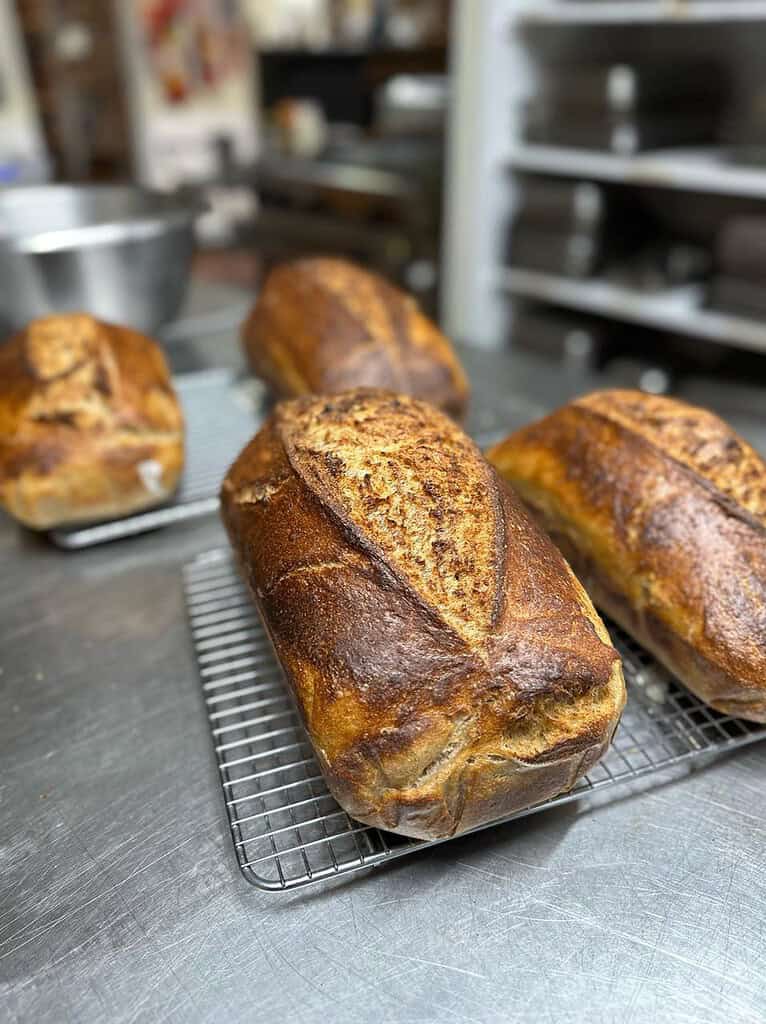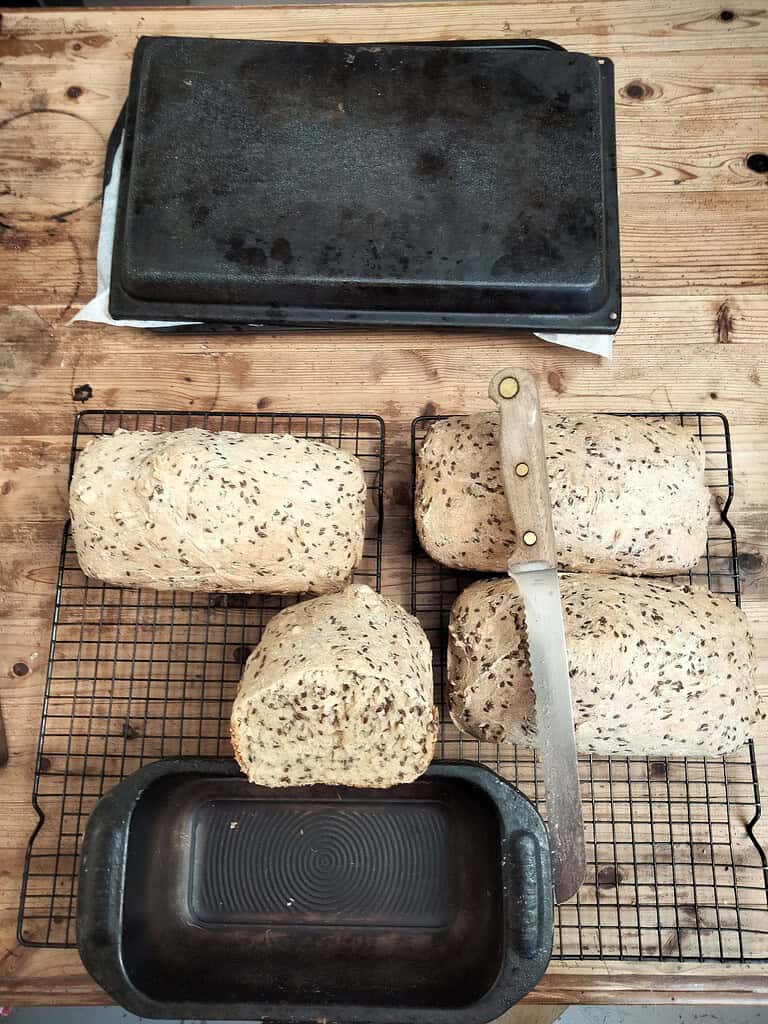Grow Food Aotea has hosted one of their very popular bread baking workshops and we’d like to share a recipe for you to try!
The first of two bread baking workshops held at Orama on May 25 with a second one being held this Saturday, 22 June. Spots still available, please see details below for booking.

15 participants gathered for a skill share on making and baking sourdough, gluten free and no knead bread with Treena Salthouse, Sue Reusser, and Caity Endt as tutors.
We were warmly hosted by the Orama crew, enjoyed a fabulous lunch of home-made bread with beautiful hummus and pumpkin soup. A perfect way to spend such a cold blustery day! If you couldn’t make it – we thought we’d share a recipe here for you to try!
Long Rise, No Knead, No Stress, No Plastic bag Bread!
This is a recipe we have refined over the years to give us GREAT bread, with the minimum of time and effort on our part. It was introduced to us by Sue Reusser who used the recipe from Gillian Polson’s “the Living Kitchen”.
When we had a full house of wwoofers we needed a lot of bread to feed the hungry hard workers and were baking every two days! So, time was of the essence and bit by bit we trimmed off unnecessary steps. (Note: For traditional kneaders this recipe may seem like heresy, but it works!)
This is a no knead, slow ferment bread. The extra water and time helps to develop the gluten which would otherwise be achieved by kneading. We use organic flour – grains unfortunately are heavily sprayed.


Long Rise no Knead no Stress Bread Recipe (2 loaves)
- We usually start this in the evening and bake the following morning – but you can do it the other way if that suits you better.
- You want around 12 hours of rising time but this is flexible. If you want it sooner add a bit more yeast.
For two high loaves of bread:
- 600 g wholemeal flour
- 600 g white flour
- ½ to one cup whole linseed
- 1 litre of warm water plus a little more if needed
- ¼ -1/2 teaspoon dried instant yeast
- 1 tsp salt (or none)
Mixing #1: max 10 minutes
- Blend the dry flours, linseed and salt together with a wooden spoon in a large heavy bowl
- Make a well in the middle and pour in the warm water
- Sprinkle in the ¼ tsp yeast and swish it through the water so it is evenly dispersed, then blend it all together with the wooden spoon til all evenly wet. (No need to wait for the instant yeast to start frothing, no sugar needed).
- Add a little extra water if it feels too stiff. It should be able to be mixed with a wooden spoon/Danish dough whisk, with a little effort.
- Pssst!: Clean the dough off the edges of the bowl with a spatula so it doesn’t dry and create a washing up nightmare the next day.
- With wet hands pat the dough to a smooth surface, then cover the bowl with baking paper which you have brushed well with oil on one side. Put the oily side down – this will stop the dough sticking to the paper, plus you can re-use the paper next time you bake! Place a tea towel over the baking paper and place the bowl somewhere warmish if you can. (Not vital).
- Leave the dough to rise slowly over the next 8-12 hours or so.
In the morning, it will have risen right up and be quite spongey. Because the grain will have hydrated, the dough may feel wetter than it was the night before. The linseed will have absorbed water but also releases oil and moisture as it bakes.
Mix #2 and fill tins (about 10 minutes)
- With your trustee wooden spoon/dough whisk mix dough again so the air is released and dough collapses.
- Oil your bread tins and dust with flour to stop sticking. (If your bread tins are well seasoned you may not need to do this).
- Divide the dough in half and place in the two tins. Pat the dough down with very wet hands or spray with water, when the bread bakes, this will enable a crunchy crust!
- score with a sharp kitchen knife about three times–
- Now here’s the great bit! NO NEED TO PREHEAT OVEN!!! You can place the tins in a COLD oven, then turn the oven on to around 180-200 – as the oven warms, the bread will rise!
- Let bake for 1 to 1 ½ hours – the bread is done when it shrinks back a little from the sides of the tin and knocking the bread sounds hollow.
- Tip hot loaves out of tins and place on rack to cool and stop them from sweating.
We freeze the extra bread after it has aired out for 24 hours. As there are only two of us, we cut the loaves in half to avoid the bread going stale once defrosted.
For a sweet variation of No Knead Bread Add the following to your dry mix:
- 1 cup brown sugar or rapadura (unrefined sugar)
- 1 cup raisins or sultanas
- ½ cup crystallised ginger
- 1 tbsp cinnamon
- ½ tsp nutmeg
- ½ tsp all spice
- Grated citrus peel (orange/lemon/mandarin) 2 tbsp
- Add an extra 200 ml of water to the 1 litre
How to minimise the washing up afterwards:
Soak everything that has had contact with the dough in cold water as soon as you are done with it to stop it sticking like concrete.
And use your hands to clean- no dish brushes – they will get clogged with gluey strands of dough.
Words by our ever talented Food Resilience Coordinator, Caity Endt

















